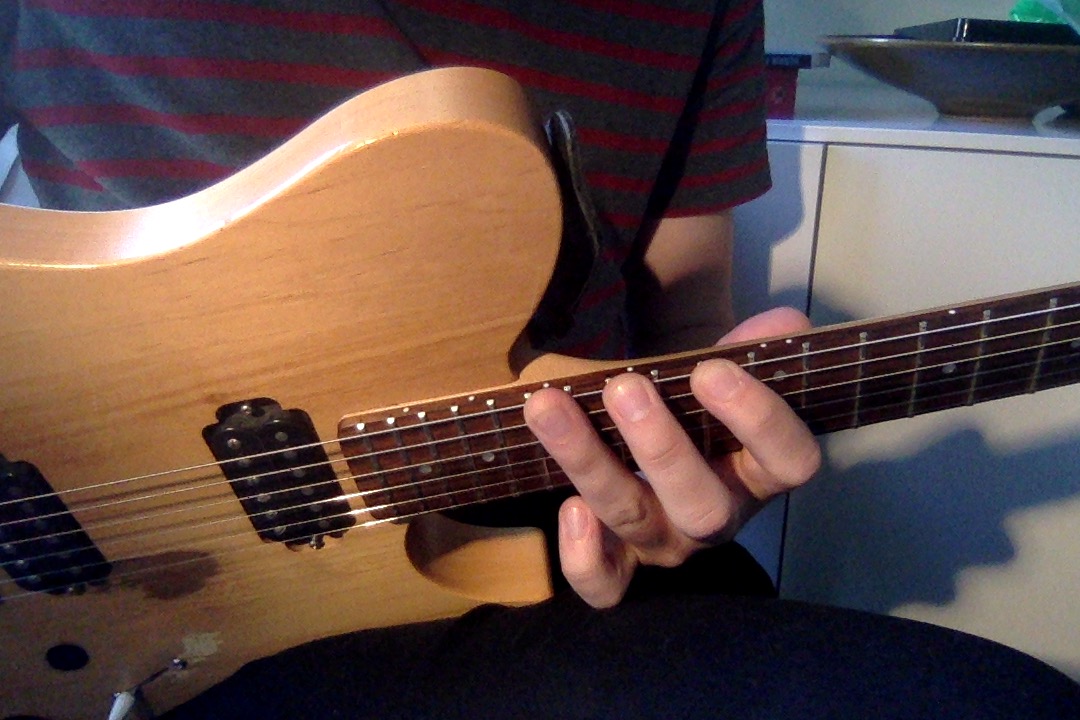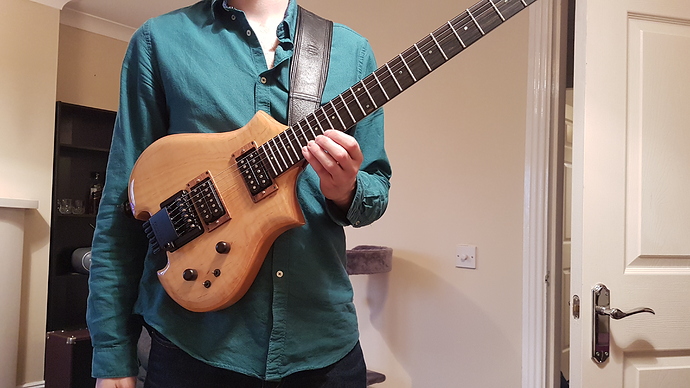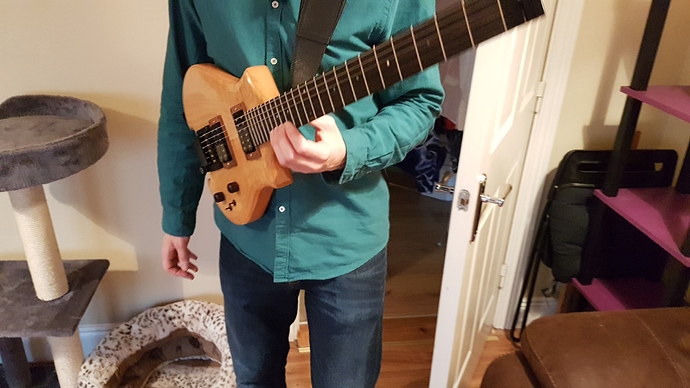Well hopefully through CTC, you might find that the BJJ impact is less problematic than we might be fearing. Best of luck!!
Ok, I’m going to try this(pause) imho(this also applies to myself btw) you are using way to much energy for the sweep on the left hand fretting side(probably the right as well), which is especially apparent fretting towards the bridge(above, or at the 12th). The pressure applied has to be so precise and quick that one doesn’t have time to tense up( think of harmonics), just enough to get a sound of differentiation(like drums-not 12 separate tones), the pressure leading to the specific expression is a byproduct of this in other words the licks don’t come first(not really) and you have more than enough for that.
What I am talking about is speed fretting and like speed picking(I’m sure you can do that), it has an effortlessness that is irreducible(it can’t be done slowly), try it on one string or a particular sweep you like, turn the amp up real loud because this activity is like a “not doing” doing, meaning barely perceptible(at first).
I just took my knobs and pots off and left the volume pot on(much further away from the strings) with no knob. To say this made a difference in about two days is a huge understatement(it has been a revelation). One last thing until recently I could not play sitting down(except strumming and such) at all, this was because the position requires an awareness of touch and feel that only a few can have from birth, but this awareness can can be developed.
I would like to say more. If you are interested I will.
I’m surprised to find a discussion about BJJ here. I’ve been reading guitar forums more again lately because I’ve been spending so much time thinking about jiu-jitsu and discussing it online.
I think a lot of the finger damage BJJ players get is from training methodology and being too stubborn with their grips, but there are definitely some games that make you more prone to finger injuries. My instructor has very poor dexterity and finger strength from years of training gripfighting with the mindset that it was about taking your grips as strongly as you can and trying to hang on to it as a training partner explosively strips them away. Now he says that good gripfighting is about being dynamic, switching between grips to stay ahead of your opponent and moving yourself to render their grips ineffective.
I don’t play much Spider guard or De La Riva. Those positions are notorious for leading to finger injuries, and they don’t really translate to NoGi.
I think NoGi is safe for the fingers, and it teaches you to play positions without relying too much on gripping fabric.
Black Star Lick. Difficulty is in left hand and hand synchronization. I build this up from just the first ornament to landing the note on the B string, to the whole lick.
My L hand has a lot of tension and you can see the extensors working hard here. I get more stiff and sore by practicing and that kind of makes me stiffer and less in control. My left hand feels smashed against the back of the neck.
(As you can see by watching the video, I’ve offset the guitar around the right side of my body to give the left hand more space.)
It seems like I picked the wrong instrument. I think I’m not coordinated enough. The guitar does not fit me. It’s too close. I don’t know how anyone can play 3 note per string scales above the 12th fret. For me, it’s impossible.
I used to be able to play sitting but now my right shoulder painsme when I do that so I only play standing. Initially, my switch to standup playing was to get performance-ready. But I never did. Now, it’s the only waythat I can play without pain but I still cannot play standing up because of the guitar being too close to the left hand.
Guitar playing is almost all physical, somewhat psychological, and only a tiny bit mental/intellectual.
I think you need to get a guitar stand that holds the guitar out in front of you - you could then test your thoughts on guitar placement and/or design. I’m still not 100% convinced that it will solve all the issues raised above, but you might be able to rule a couple of things out.
I’m not sure what your getting at here and I wouldn’t necessarily agree.
But you are on the videos above??? And its not a snail’s pace…
Granted, playing above the 12 fret is harder and super hard by comparison from 15 onwards on the bass strings - but how often do players do that? There are alternative fingerings that can be used.
Looking at the blackstar video above, you can definitely see you difficulty with the thumb placement - notice that when you curl your thumb to move it behind the neck a little, your palm and fingers don’t really move around the neck (which is the purpose of moving your thumb). Maybe try and flip the thinking here- don’t move your thumb to move your hand. Instead, move your palm and fingers to where you need them to be and let your (relaxed) thumb follow your hand. The thumb doesn’t move to move your hand - it just supports your hand wherever it needs to be. Also, don’t try and curl your thumb as you move it back - this will curl your fingers in (as per your other thread).
Give it a go and try and chill out with the tension. Think ‘tactile’ rather than ‘physical’.
I guess best solution is to go to a guitar store and try as many guitars as possible until GS workers get mad
I, personally, don’t have such opportunity so I play half-self-made frenkenstein ))
I feel you here. I have also had big problems with this as my hands are quite small, at least if you compare with Gilbert who can play 3 note per string anywhere on the neck. What has always been increadibly hard to reach both sitting and (even more) standing, is playing 3 note per string on the low E-string above the 12th fret. Especially when notes have som space between the.
So trying to fix it I realised there are a few differnet ways of fingering a lick like 13-15-17 to be able to reach better. First off is my traditional use of index, long, pinky. This is almost impossible for me.
Next way is the Gilbert way. This makes reaching much easier and is the way I would prefer to do it.
Last one, and by far the best reach strangely enough, is completely getting rid of the pinky. Another thing that this helps with, for me, is slightly lowering the index finger over the strings for muting, something that is impossible if I use the two other versions. But, of course, not using the pinky just feels wrong.  But at the same time, this is the Yngwie way and who can argue with that.
But at the same time, this is the Yngwie way and who can argue with that.
I read through the whole thread. It’s difficult to put in words what would probably be clear in 1 minute in real life. What I got from what you said in terms of problems and solutions:
I see that indeed your left hand is cramped and has no space to move forward. Leaning with your forearm on the body to angle the neck outward is not an option for you. I also see that your guitar position is much to your right.
To solve this you have a couple of options:
-
meet up with a good guitar teacher who can find a solution with you
-
put your guitar on a stand and walk around it and vary the height and distance until you find out where the optimal position is for you. ideally in the presence of a guitar teacher.
-
put a pillow between you and the guitar
-
step forward with your right leg and position your guitar in your groin, which makes it go left and a bit angled forward and creates space for your left hand.
Personally I recommend getting a guitar teacher.
Best of luck
There aren’t any. Look at what the ‘experts’ on this forum have to say.
I’ll do that. But then what? Only I can think of is to design a guitar that will be more likely to rest in that position. That’s about $5,000 and hope it actually works.
I did that. It helped some. Moving the strap buttons helped more.
[quote]4. step forward with your right leg and position your guitar in your groin, which makes it go left and a bit angled forward and creates space for your left hand.
[/quote]
That works for some things. It’s too much for playing one lick or a few notes and it requires a bit of preparation to set up, not moving the guitar in 16th notes. It’s also holding in that position and that leads to buildup of tension and strain, shoulder, back, and hamstring issues.
Dude, I’m calling you out on bad attitude and rudeness.
Have you tried installing a strap pin at the neck heel? This will shift the position of the neck forward as the guitar hangs.
Have I tried putting the strap button behind the heel? No. On this guitar, that would put the strap is too close together. That’s the gist of it but if that’s hard to understand, I’ve demonstrated in the video.
What happens when there’s more room…
AISB, sitting down and playing does tend to hurt my right shoulder. But it’s not hurting me at now.
I won’t make any promises, but I think the issues would be mostly resolved with one strap pin behind the neck heel and the other in the conventional position on the body. I think putting the other strap pin on the body contour is partly responsible for the strap cutting into your lat and causing discomfort.
Here’s how my guitar hangs on me. Plenty of space behind the neck for me to work with, and the strap doesn’t cut into my back at all.
Ignore the fact that the guitar is headless, you can achieve a similar balance with a conventional guitar. My Strat and SuperStrat style guitars have pins added at the neck heel. Actually, since the body is so small, my strap pins are quite close together, but the strap is well padded and the trap hangs away from my body.
I think a big, padded strap and some experimentation with the strap pins might be all you really need. If you’re hesitant to do it to your own guitar, you could pick up a cheap, used RG to try the different positions on.
I purchased the M brace stand but could not get it to screw into either of the mic stands I own. Looks like it should fit but it does not. I’m initiating a return.
I have to earn some money so I’m getting a job now and I won’t have time, Mind, or energy for music.
I’d like to find a guitar that I can play standing up so that I can play higher up on the neck, especially on the lower strings. If I could play three NPS skills in 15th position, legato, that would be great.
@GTR My man, this is an issue I have been struggling with since I started.
I can not even begin to comprehend how people are able to play superstrat shaped guitars when standing up and wearing them low.
I have found that for me personally, a V shaped guitar is so much more comfortable (especially for the left hand) that I refuse to play anything else.
Let me explain why:
For me personally, my right hand “requires” the guitar to be placed lower. In a regular scenario this would mean sacrificing left hand comfort, however V’s have 3 very particular advantages in this regard:
-
With proper strap pin placement and good balance, the necks of most V’s naturally sit at a 45 degree angle. This is as close as you can get to a seated classical position. Having played Ibanez RG’s for a while, their natural neck position when standing up is what I would personally (and subjectively) describe as “severe neck dive”.
-
The 2nd factor is way more subtle, however just as influential. From what you described, this should interest you greatly. With a strap pin placed behind the neck (For refference see neck through Jackson KV’s and RR’s) as opposed to on a horn, the guitar has an inclination to tilt forward and away from the body in 2 “ways”.
-
firstly, the top of the neck (Low E side) is tilted forward and away from your body, enabling you to reach over for the low strings MUCH easier… as opposed to superstrat shapes where the Low E side of the neck is tilted towards your body. I have found this to be a TREMENDOUS factor when it comes to comfort and stretchy stuff.
-
secondly, because of the shape itself, the entire neck is angled away from your body. This allows for way more room when playing higher up the neck. Someone in the pervious replies had suggested pushing on the guitar body with your right forearm to bring the neck further away from your body, however this has a very limited range and efficiency compared to V’s. In my case, all I need to do is push the neck away with my left hand and it is more than gappy to move further away and remain there with no extra effort. As an added bonus, when pushing the neck away with a V, the lower horn of the body moves in between your legs, enabling you to “lock” it in place, which brings us to point number 3:
-
-
The wings of a V style guitar can be used to “hook” the body of the guitar to your right leg, thereby providing extra stability turning the guitar into a non-moving target. I have found this to be particularly usefull during lead playing that involves wide horizontal jumps and/or stretches.
So that’s it, my friend. Know that you are not alone, and while most people are (somehow) perfectly happy with a superstrat shape, a V style guitar might prove to be the most ergonomic choice for you, as it has been for me. I suggest you go to a store and try a few V’s. It might turn out to be the miracle cure for you as well!
P.S - Dear @Troy , I have found this to be a major issue, please check out my little essay hahah
Hi, Alex. That’s a great post and I’m glad to know that I’m not alone.
Now I’m really thinking about getting a V-shape guitar.
What’s a good V guitar? I’ve had bad experiences with Jackson guitars in the past. They routed the Floyd Rose directly into the wood, causing the guitar to always be out of tune. They also tend to sound pretty bad.
Several months ago, I tried a James Hatfield Vulture ESP. The guitar balanced amazingly well. It sounded amazing with distortion, too. What I disliked about it was the placement of the volume knobs with the combination of very high output pick ups. I like to use the volume knob so that I can dial back the gain and control dynamics. The neck was a bit too narrow. However, I now regret not purchasing that guitar, as it was on clearance then and I could have paid to relocate the volume knobs and change the pick ups.
If you are dead set on wide and flat Ibanez-style necks, Jackson would be a good choice. Id’ suggest looking into the pro-series King V and RR models.
The problems you described from your past experience with them shouldn’t be a thing with today’s models.
Alex, your responses are motivating me to buy a V.
What are some of the coolest Vs you guys see here?
https://www.guitarcenter.com/search?Ntt=V+guitar
Everybody, post some pics of cool guitars for me
EDIT: what is the difference between the ProSeries King V and the king V?
The Rhoads V has a smaller lower horn. The bigger lower horn on the king V seems like it’ll go into my leg better






